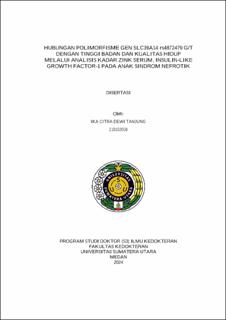| dc.description.abstract | Background. Nephrotic syndrome (NS) is a chronic kidney disease that is often found in children with corticosteroids as one of the managements given. The long-term impact of chronic disease conditions and corticosteroid therapy given on non-renal aspects is short stature and impaired quality of life (QoL). Physical growth is influenced by genetic and environmental factors. The environmental factors that influence physical growth include nutritional intake, growth hormones, physical activity and disease suffered in children. Zinc is an importanta micronutrient in the body and insulin-like growth factor-1 (GF-1) as a growth factor hormone influences height growth. Zinc homeostasis in the body is regulated by the zinc transporter family, one of which is the ZIP14 protein coded by SLC39A14 gene, which functions as a zinc importer into cells. The influence of the SLC39A14 gene polymorphism on serum zinc levels, IGF-1, body height and quality of life is unclear.
Aim. To analyze the relationship between SLC39A14 rs4872479 G/T gene polymorphism and body height and quality of life through analyzing serum zinc and IGF-1 levels in NS children.
Method. The study design was a case control study with 41 NS children as cases and 41 healthy children as controls from February 2023 to February 2024. Height measurements was done in all children, QoL based on parent and child reports using menggunakan the PedsQL 4.0 generic core scales, SLC39A14 gene polymorphism examination using real time-polymerase chain reaction (RT-PCR) method, serum zinc levels using inductively coupled plasma-mass spectrometry (ICP-MS) method dan IGF-1 using immunochemiluminescent method. All data processed by SPSS version 23.0.
Results. Short stature was the same in both groups, namely 9 children (22.0%). TheQoL of 5 NS children (12,2%) was disturbed and it is greater than healthy children namely 2 (4.9%), however there was no QoL difference in both groups (p= 0.432). The mean height of NS children (140.73 cm) was lower than healthy children (144.71 cm), however there was no mean height difference in both groups (p= 0.289). The mean zinc levels in NS children (64.44 μg/dL) were lower than healthy children (81.90 μg/dL), and there was a significant mean zinc difference in both groups (p < 0.001). The mean IGF-1 level in NS children (187.73 ng/mL) was lower than in healthy children (193.88 ng/mL), however there was no mean IGF-1 level difference in both groups (p= 0.735). The highest proportion of genotype variants in both groups was GG 36 (87.8%) in NS children and 31 (75.6%) in healthy children. There was no difference in mean serum zinc and IGF-1 levels based on the SLC39A14 gene variant in both groups and there was no influence of the SLC39A14 gene polymorphism on QoL (p= 1.000).
Conclusion. There is no relationship between the SLC39A14 gene polymorphism and body height and QoL. | en_US |


